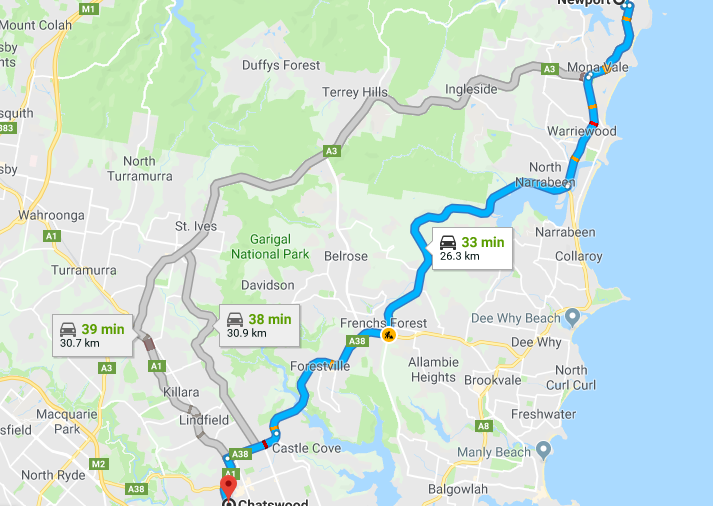If you live in Newport and work in Chatswood, it’s quicker for you to cycle than to drive or take public transport. But being faster is not the same as being safer. Deaths and serious injuries from cycling went up last year more than other types of transport. So the decision about how to get around is not as simple as it looks.
Newport to Chatswood
Northern Beaches Council, among others, wants to improve transport in the area. It just ran an experiment to gauge travel time on the 26kms journey from Newport to Chatswood. These are the, perhaps surprising, results:
| Method | Time | Average speed |
| Cycling | 57 minutes | 27kmh |
| Car | 64 mins | 24kmh |
| Bus plus train | 91mins | 17kmh |
| Buses only | 116 mins | 13kmh |
Cycling
Cycling was the fastest method with an average speed of 27kmh. This was twice as fast as the bus-only option of only 13 kmh, in part because of connection waiting times. Cycling was marginally faster than driving by car, though this particular cyclist could have been more skilled than average. Taking longer to drive may also outweigh the extra risks of cycling.
In fact, you need to cycle 47kms to have a one in a million chance of dying on the road. Riding a bicycle at moderate or high intensity is also good exercise. A BMJ study in the UK found cycling to work reduced risk of death from all causes by 40%.
Even so, drivers do not always see cyclists, not because they are bad drivers, but because their attention is divided. A Canadian study found 58% of drivers failed, before turning, to gaze at the spot where cyclists would be and did not make frequent over-the-shoulder checks. So cyclist beware.
Walking
Of course, walking was not an option from Newport to Chatswood as it would take over 2 hours. But walking 10kms or more a week reduces your risk of heart disease by 27% and death from heart disease by 36%. Moreover, you have to walk 27kms (Newport to Chatswood!) to have a one in a million chance of dying while walking.
Everyone has to walk between types of public transport and this can take extra time.
Public transport
The safest way to travel is by train, as you must go 10,000 kms to have a one in a million chance of dying. One study says there is a six-fold chance of getting a respiratory illness on public transport but another claims regular travel of this kind helps build immunity.
Bus travel is still safer than car trips per kilometre travelled: there are five times more fatal and severe injuries in cars than on buses. Buses are intrinsically safer because:
- Drivers are professionally trained
- They drive more slowly than cars
- They travel along designated routes and often in one lane
- Far fewer buses than cars are needed to transport the same number of people.
But current bus trips may still be psychologically too long for some commuters.
Driving or riding
Travelling by car is about seven times safer than cycling and you could travel 330kms to have a one in a million chance of dying. Conversely, riding a motorcycle is the riskiest as you need travel only 10kms to have the same chance. You are also thousand times more likely to die on a motorbike than in a train.
In the Newport to Chatswood example, driving in a car was only marginally slower than the bicycle but much faster than taking public transport.
In fact, most Australians (87%) just prefer to drive to work, even if the risk of injury is four times higher than for people on buses. Drivers may also be affected by peak hour congestion, bad weather, poor road conditions or emotional problems. In spite of constant pressure to pay attention to other vehicles, pedestrians or road signs, many still prefer the comfort and familiarity of their own space.


your opinion matters: